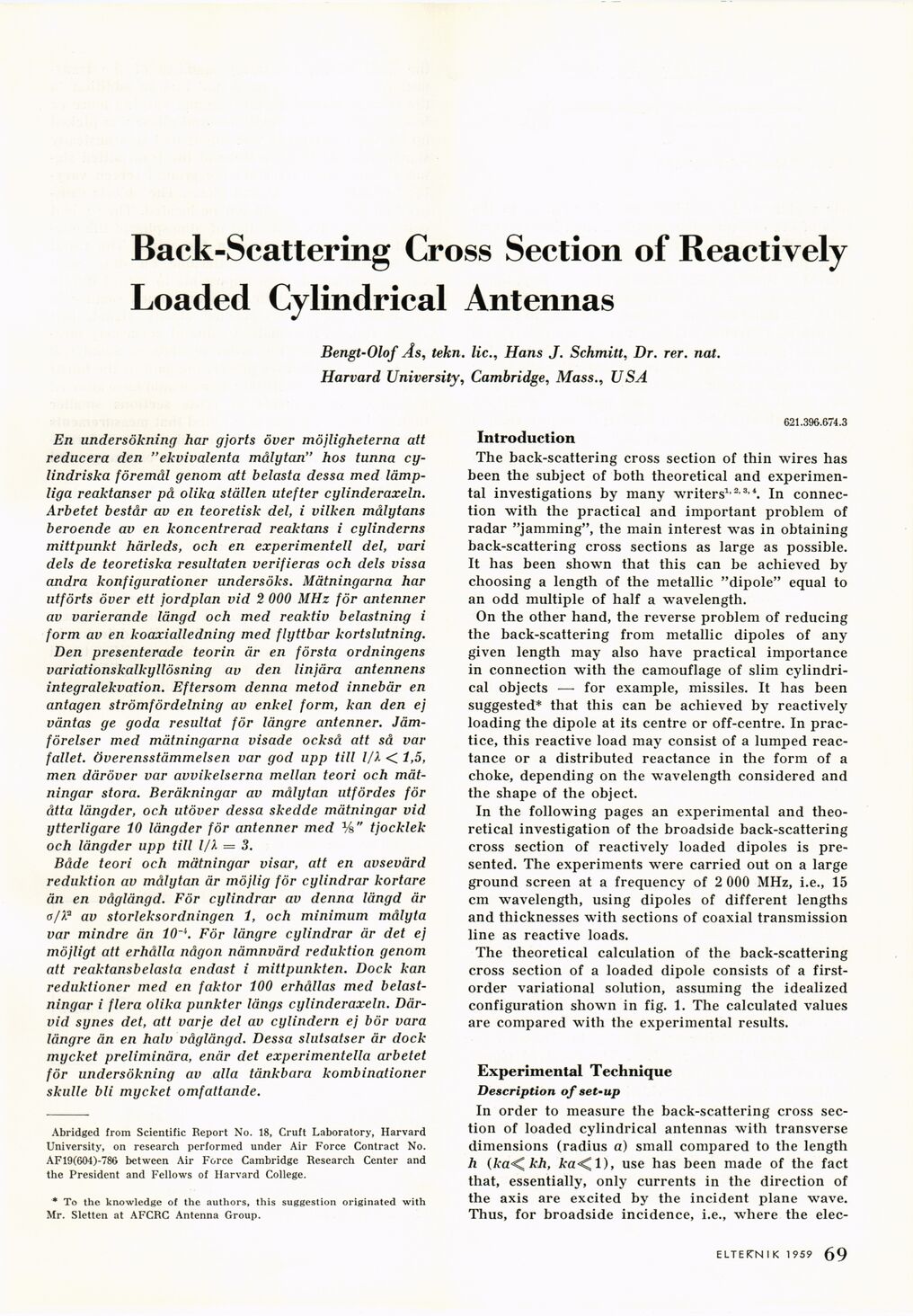
Full resolution (JPEG) - On this page / på denna sida - 1959, H. 5 - Back-Scattering Cross Section of Reactively Loaded Cylindrical Antennas, by Bengt-Olof Ås and Hans J. Schmitt

<< prev. page << föreg. sida << >> nästa sida >> next page >>
Below is the raw OCR text
from the above scanned image.
Do you see an error? Proofread the page now!
Här nedan syns maskintolkade texten från faksimilbilden ovan.
Ser du något fel? Korrekturläs sidan nu!
This page has never been proofread. / Denna sida har aldrig korrekturlästs.
Back-Scattering Cross Section of Reactively
Loaded Cylindrical Antennas
Bengt-Olof As, tekn. lie., Hans J. Schmitt, Dr. rer. nat.
Harvard University, Cambridge, Mass., USA
En undersökning har gjorts över möjligheterna att
reducera den "ekvivalenta målytan" hos tunna
cylindriska föremål genom att belasta dessa med
lämpliga reaktanser på olika ställen utefter cylinderaxeln.
Arbetet består av en teoretisk del, i vilken målytans
beroende av en koncentrerad reaktans i cylinderns
mittpunkt härleds, och en experimentell del, vari
dels de teoretiska resultaten verifieras och dels vissa
andra konfigurationer undersöks. Mätningarna har
utförts över ett jordplan vid 2 000 MHz för antenner
av varierande längd och med reaktiv belastning i
form av en koaxialledning med flyttbar kortslutning.
Den presenterade teorin är en första ordningens
variationskalkyllösning av den linjära antennens
integralekvation. Eftersom denna metod innebär en
antagen strömfördelning av enkel form, kan den ej
väntas ge goda resultat för längre antenner.
Jämförelser med mätningarna visade också att så var
fallet, överensstämmelsen var god upp till l/X < 1,5,
men däröver var avvikelserna mellan teori och
mätningar stora. Beräkningar av målytan utfördes för
åtta längder, och utöver dessa skedde mätningar vid
ytterligare 10 längder för antenner med Ys" tjocklek
och längder upp till l/X = 3.
Både teori och mätningar visar, att en avsevärd
reduktion av målytan är möjlig för cylindrar kortare
än en våglängd. För cylindrar av denna längd år
o/)? av storleksordningen 1, och minimum målyta
var mindre än 10~\ För längre cylindrar är det ej
möjligt att erhålla någon nämnvärd reduktion genom
att reaktansbelasta endast i mittpunkten. Dock kan
reduktioner med en faktor 100 erhållas med
belastningar i flera olika punkter längs cylinderaxeln.
Därvid synes det, att varje del av cylindern ej bör vara
längre än en halv våglängd. Dessa slutsatser är dock
mycket preliminära, enär det experimentella arbetet
för undersökning av alla tänkbara kombinationer
skulle bli mycket omfattande.
Abridged from Scientific Report No. 18, Cruft Laboratory, Harvard
University, on research performed under Air Force Contract No.
AF19(604)-786 between Air Force Cambridge Research Center and
the President and Fellows of Harvard College.
* To the knowledge of the authors, this suggestion originated with
Mr. Sletten at AFCRC Antenna Group.
621.396.674.3
Introduction
The back-scattering cross section of thin wires has
been the subject of both theoretical and
experimental investigations by many writers1,2,3,\ In
connection with the practical and important problem of
radar "jamming", the main interest was in obtaining
back-scattering cross sections as large as possible.
It has been shown that this can be achieved by
choosing a length of the metallic "dipole" equal to
an odd multiple of half a wavelength.
On the other hand, the reverse problem of reducing
the back-scattering from metallic dipoles of any
given length may also have practical importance
in connection with the camouflage of slim
cylindrical objects —• for example, missiles. It has been
suggested* that this can be achieved by reactively
loading the dipole at its centre or off-centre. In
practice, this reactive load may consist of a lumped
reactance or a distributed reactance in the form of a
choke, depending on the wavelength considered and
the shape of the object.
In the following pages an experimental and
theoretical investigation of the broadside back-scattering
cross section of reactively loaded dipoles is
presented. The experiments were carried out on a large
ground screen at a frequency of 2 000 MHz, i.e., 15
cm wavelength, using dipoles of different lengths
and thicknesses with sections of coaxial transmission
line as reactive loads.
The theoretical calculation of the back-scattering
cross section of a loaded dipole consists of a
first-order variational solution, assuming the idealized
configuration shown in fig. 1. The calculated values
are compared with the experimental results.
Experimental Technique
Description of set-up
In order to measure the back-scattering cross
section of loaded cylindrical antennas with transverse
dimensions (radius a) small compared to the length
h (ka^kh, ka<^ 1), use has been made of the fact
that, essentially, only currents in the direction of
the axis are excited by the incident plane wrave.
Thus, for broadside incidence, i.e., where the elec-
ELTEFCN I K 1 959 69
<< prev. page << föreg. sida << >> nästa sida >> next page >>